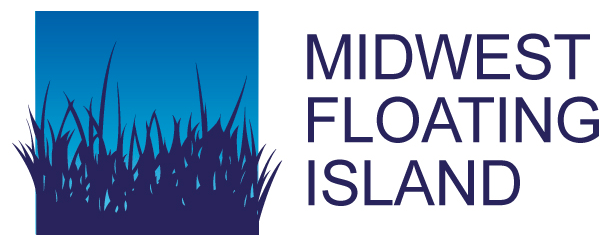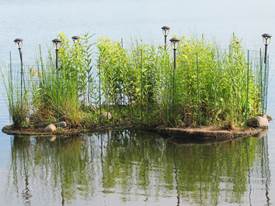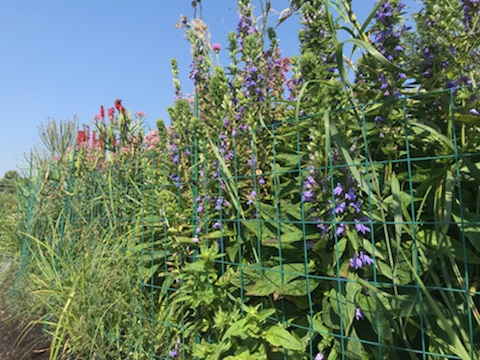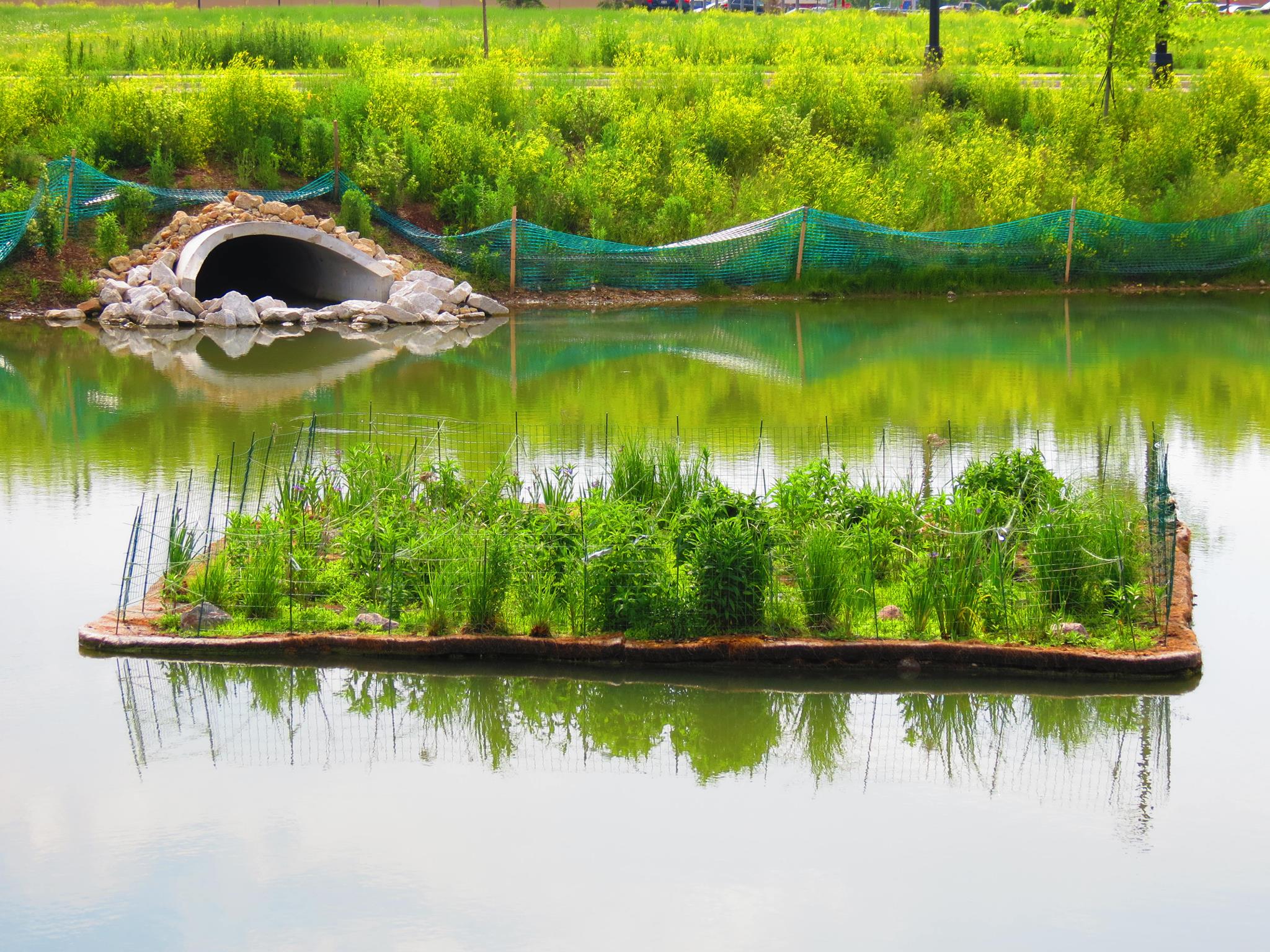Like the flower gardens in your yard, Floating Islands, or Floating Treatment Wetlands as they are sometimes called, benefit from planning and maintenance to keep them looking nice for many years.
Plants for Floating Wetlands
We recommend native wetland plants. We usually order 2″ plant plugs which work well with our 3″ plant holes cored into the islands.
Native wetland plants which grow well on the shoreline in your geography should also flourish on the islands. You may want to have a variety of plants and heights for both biodiversity and visual appeal.
I like to include some swamp milkweed plants on islands to provide valuable habitat for the monarch butterfly. After hatching, monarch caterpillars feed exclusively on milkweed.
Carex (family Cyperaceae) is a popular sedge to plant. Blue Vervain does well also. Check with your local native nursery for suggestions.
You will need to consider the height of your plants. Very tall plants can create a sail effect and put extra pressure on the anchoring. Shorter plants will be better to avoid that stress on the anchors. We typically use a combination- we place some tall plants in the center of the islands and shorter plants on the edges.
It is best if the plants do not root in and instead remain free-floating. This will give you the best water-cleaning results, so try to anchor the floating wetland in a location with 3 feet or more of water.
It is important to water the plants well in the first few weeks. Remember these are wetland plants. They will be going through some “transplant shock” from replanting and you do not want the planting mixture to dry out. Plan to water daily if you do not get rain until the plant roots get down enough to pull up water from the waterbody. Some people choose to keep the islands tethered to shore during the first few weeks and just water the plants by tossing pond water on the plants. You can anchor once the roots can self-water. Keeping the wetland plants well-watered in the beginning will help to ensure a lush look longer term.
General Maintenance Considerations for Floating Treatment Wetlands
It is your personal choice whether to tend your BioHaven floating island like a garden or allow it to grow naturally.
Invasive species on the shoreline can spread seeds to the Floating Treatment Wetland (FTW) or floating island. Invasive species are plants which are not native to the area and can cause harm. It is ideal if you remove the invasive species from the shoreline before installing your floating island. Inspect for invasive plants such as reed canary grass, purple loosestrife, and invasive cattails which can crowd out your native plants. You can apply can an approved aquatic herbicide to the stalks.
Important- do not let volunteer trees grow on the island. Their height and root ball weight can cause instability.
You can clean up the island either in the fall or in the early spring by removing the leaves that died off in the fall if you prefer a cleaner look. It does not hurt the island to let the leaves and stalks stay on the island, but the decomposing material adds weight and provides a place for weeds to grow so it is helpful to reduce the dead leaves. However, we have many customers who choose to let the islands be completely natural and do not worry about weeds or invasive plants.
Some people assume they should use fencing to prevent the plant from falling back into the water in the fall. Plant uptake only accounts for around 7% of the nutrient removal, so this is not a major issue if cutting back the plants in the fall is not practical or desired.
Some customers choose to replant after 5 years if some of the plants look tired or if invasive plants are taken over the island. You may be able to kill the widespread invasive plants without chemicals if you place a black tarp over the plants during very hot weeks. Once they have been killed, you can place a float on the anchor lines and tow the islands into shore to replant.
If aesthetics are important and there is a lot of debris blowing in that area, visit the islands a few times during the year to remove possible trash.
Keeping Out the Water Terrorists- Geese
Geese and ducks use wetlands as feeding, resting, and nesting areas. We sometimes refer to geese as water terrorists. Geese have been know to pull up all the new plants the same day you toiled to put them in. They have looked greedily at us when we were planting. Evil scowls directed at geese does not stop them. They have also dive bombed fencing intended keep them off the islands.
Canadian Geese are federally protected birds and you cannot disturb a nest with eggs so you need to be creative. Consider bringing a dog in your canoe as you move around the islands. You can also install perimeter fencing or fencing with cross strings. I recommend creating a way to open the fencing for maintenance tasks.
If perimeter fencing is installed to discourage geese, you may need to straighten the fencing over time if geese dive bomb or if ice skaters run into the fencing over the winter. Some people only use perimeter fencing at the beginning when the plants are getting established. Others keep the fencing longer term to prevent the tall plants from falling back into the water in the fall, but this should not dramatically affect water quality. As discussed above, plant uptake is only around 7% of nutrient removal.
Others put twiggy branches between the new plants to discourage geese.
Anchoring and Chemical Maintenance with Floating Wetland Islands
Your floating island may occasionally float low in the water after rain. Normally it will recover buoyancy on its own.
Avoid using chemicals such as algaecides and pesticides. These will cause the floating wetland to float lower. The floating treatment wetland should return to regularly buoyancy after a few weeks if the chemical is not repeated.
Harsh chemical flocs like alum can hurt colonization of microbes and invertebrates which naturally clean and filter the water. Dragonflies and water bugs, for example, feed on organic muck. The invertebrates are also important in the food chain because birds, frogs, and fish feed on invertebrates. Copper was noted to hurt microbial activity even at low levels (Leland & Carter, 1985).
Floating treatment wetlands are an alternative to chemicals. Use of chemicals can kill beneficial microbes that floating islands rely on, affecting their buoyancy and their efficacy. They will typically float higher after a few weeks as the biofilm returns.
Avoid using chemical fertilizer on your floating wetland island. Compost can be used early on when mixed with peat and soil to help the new plants get off to a good start.
Check your anchoring 2-4 times a year. After large storms with high winds and extremely high water levels, the anchors will have a lot of pressure and may need to be re-secured.
We are happy to talk with you about other tips. Please feel free to contact us.
Midwest Floating Island
A Division of Bro-Tex, Inc.
800 Hampden Ave | Saint Paul, MN 55114
Autumn’s direct dial 651-379-2492
autumn@midwestfloatingisland.com | www.midwestfloatingisland.com




One Comment on ““Island Maintenance””
I am associated with a small nature conservancy in West Bend WI. On the property we have a small kettle lake approx. 35 feet deep and about 7 acres in size. Recently there was a raw sewage spill into the lake and we are looking at means for remediation.
I am also looking for information to place a small floating island on my own wildlife pond.
I would appreciate someone reaching out with some more information.
Thank you